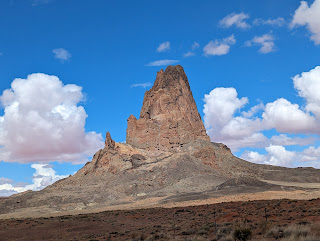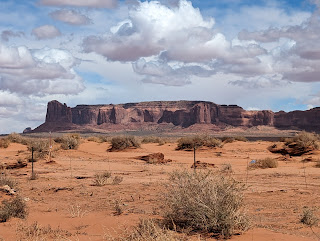After spending a fun month mostly exploring the mountain trails around the Phoenix suburb of Tempe, it was time to head home to Colorado, 800 miles northeast. As we did on the trip to Phoenix, we chose to take the 'slow road' from Phoenix home, driving through the incomparable Monument Valley from northeast Arizona through a smidge of southeast Utah before entering southwest Colorado.
The small community of Cameron in northern Arizona was located on the Navajo reservation.
Steven and I were reminded of this country's stunning natural beauty as we headed northeast to Monument Valley on the Arizona-Utah border. It had been several years since we'd driven the looping, 17-mile Valley Drive, one of the US's most famous drives.
We couldn't figure out how people eke out an existence in this barren environment.
These silos were in the middle of absolute nowhere with nothing and no one else around for miles and miles.
We stopped at the Burger King in Kayenta, Arizona after seeing signs promoting their Code Talker Exhibit and reading about it on Roadside America. It told the story of World War II Navajo Marines who deployed as communications experts using their native language as the only unbreakable code in modern military history. The code consisted of about 200 characters and a vocabulary of 411 terms that could be memorized and used lightning-fast. The US Marines would never have taken Iwo Jima if it hadn't been for the Navajo because the entire operation was directed by Navajo code.
In just one 48-hour period, six Navajo radio nets operated around the clock sending and receiving over 8,000 messages without a single error. They helped save thousands of American lives and significantly shortened the war.
The messages included anything concerning the location and strength of the energy, the time and place of attack, and missions and maneuvers. The Code Talkers had to improvise when faced with words not in their language: "mortar" became "gun that squats;" "aircraft carrier" became "bird carrier;" and "fighter plane" was "hummingbird."
You could see how the incomparable Monument Valley was frequently a filming location for Western movies!
The red-sand desert region is known for towering sandstone buttes.
Welcome to Utah and its San Juan County aka The World's Greatest Outdoor Museum!
Just over the border into SE Utah from NE Arizona:
The famous running scene from the 1994 movie Forrest Gump was shot on the scenic highway.
Forrest Gump Hill is always such a popular photo stop that drivers have to be ultra careful of people standing in the middle of the road taking selfies with jaw-dropping views behind them.
The striations in the rocks looked just like the rippled afghan I was knitting while driving through Monument Valley!
Overlooking the San Juan River was the hamlet of Mexican Hat even though the rock formation of the same name was two-plus miles away.
This was our first view of the iconic Mexican Hat rock formation that resembled a sombrero from some angles. We couldn't resist taking the turnoff to get much better views from different perspectives.
Highway 163 was also called the Navajo Code Talkers Highway.
Entering SW Colorado: Definitely not a view that people generally associate with our mountainous state!
It looked like the Ute Mountain Casino was the only thing that kept tiny Towaoc going.
I had Steven turn the car around so I could get this shot of Trump's likeness in the heavily Republican southwest part of the state!
Hitting the relatively big town of Durango for the night was a bit of a culture shock after seeing barely anything but out-of-this-world rock formations for the previous few hours! If we ever get back there, I hope we'll have time to stop a spell and take photos of its historic town center.
Posted on April 23rd, 2024 from another rainy day in Denver. We shouldn't be surprised or bummed as April is the wettest month after all! Please take care of yourself and your loved ones.
Next post: Durango-Denver via the Million Dollar Highway!













































No comments:
Post a Comment